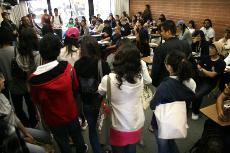DVC faculty members call it a “no-growth” policy; college administrators insist it is a “right size” policy.
Whatever the name, students felt its effects this semester as they attempted to add into overflowing classes, only to be turned away. Carolina Espinosa tried to enroll into Psychology 122, a class required for her major in criminal law. There was no room, no wait list and no possibility of an additional section.
“It’s really frustrating,” Espinosa said. “There [were] so many people in there.” The same door slammed shut on freshman James Jeong, an electrical engineering major.
“This is my first semester, so it’s really hard to register,” he said. “Most of the classes were closed when I tried.” Stories like Espinosa and Jeong’s were echoed across the campus, as hundreds of students tried in vain to register for courses already filled to the maximum. DVC administrators said the class crunch was inevitable, given the district’s demand that the college stay within its budget.
“For five years the college attempted to grow into its schedule, and [was] unable to do so,” said DVC President Judy Walters. “… We were $2 million in the red.”
The solution, she said, was to either raise the number of students in a class, reduce the number of weeks in the semester or to cut the class.
Walters and Susan Lamb, vice president of academic affairs, chose the latter alternative.
In addition to telling the divisions to cut some classes for fall and semesters, they also would not allow them to add extra sections when in-demand classes filled to the maximum. Walters said they selected the option that would have the least impact on students. “If we ‘right size’ this year, we may be able to grow more next year,” she said. One week after the first day of classes, overall head count of students at DVC had increased 4.2 percent, while the number of class sections was down by 99 or 4.5 percent, according to official enrollment reports. But students’ frustration was shared by faculty members, who were told by their deans additional sections could not be opened, despite the demand. Calling the situation “heart breaking, “English instructor Laury Fischer said, “I don’t understand how you grow a college by denying a student an education.” English instructor Susan Browne said she could have filled at least one additional section of English 224 online. “I spent a great deal of time saying no to students, either face-to-face or through written emails,” she said. English instructor Keri Dulaney-Greger said she turned away about 10 students from each of her two English 122 classes and instructor Marcia Goodman sent away 20 from hers. “My classes were stuffed,” Goodman said, “and I felt terrible about turning people away.”
“I remember a time when we took hopeful students’ names,” Dulaney-Greger said, “and if there was enough demand, a new section or two would open up.” She called the class crunch “too bad for [students], for us, and a sad commentary on the district’s poor financial planning.” Other departments also felt the pinch.
Physics instructor Joe Krivicich expressed his concern over the administration’s orders to cut additional sections of a popular physics class in the upcoming spring semester, despite the department’s current 101 percent enrollment. “There’s clearly a demand,” Krivicich said, “and normally in years past, if we saw growth like this in the fall, we would be adding sections in the spring, not subtracting sections.
“It just doesn’t make a lot of sense.”






































































